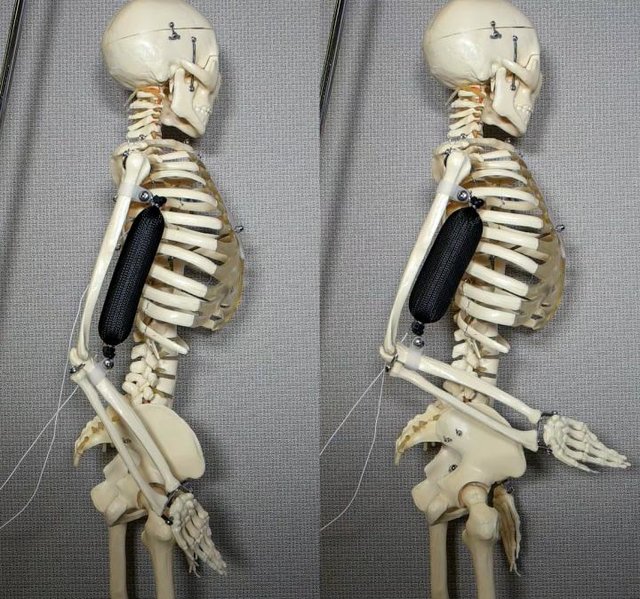 |
| The artificial muscle in use as a bicep lifts a skeleton's arm to a 90 degree position. |
They may be coming. For the first time, scientists have created an artificial muscle that works in a way similar to natural muscle and could give robots the graceful movements of a human, along with the strength of an industrial machine.
Inspired by human muscle tissue that has the intrinsic capability of expanding and contracting, Aslan Miriyev, a postdoctoral researcher in Columbia University’s Creative Machines Lab, developed a soft, synthetic muscle that can push, pull, bend, and twist in response to heat. In lab experiments, Miriyev and his team showed that the material could expand up to 15 times more than natural muscle and was three times stronger. They also demonstrated that the synthetic muscle was capable of lifting more than 1,000 times its own weight. The findings were published in the journal Nature Communications.
Because the muscle is easy to fabricate and is made from inexpensive, environmentally safe, and biocompatible materials, it could lead to advanced developments in biomedical devices that assist people with physical impairments. I might also advance the development of surgical robots that can grip and manipulate tools or soft tissue, and it could usher in a host of new soft robots able to work safely side-by-side with humans and perform delicate and precise tasks.
“The simplest thing is picking a tomato,” said Miriyev. “If you use a conventional robot, you’ll probably end up with juice.”
“It’s a little bit scary to use — for example, if you want to put it inside a robot for childcare or elderly care,” said Miriyev.
The material Miriyev and his colleagues developed doesn’t require outside pumps or other external equipment and requires around 10 volts to work.
To make the artificial muscle, the scientists mixed ethanol — a common ingredient used in everything from alcoholic beverages to cleaning products — with liquid silicone rubber. After mixing, microscopic bubbles of ethanol disperse throughout the rubber, and after it cures, the bubbles settle into tiny pockets within the rubber.
By embedding a very thin wire into the matrix of the rubber, the researchers were able to direct a low-voltage current through the material, heating it to 78.4 degrees Celsius (166.6 degrees Fahrenheit), the boiling temperature of ethanol. The boiling increases the volume of the ethanol bubbles — and expands the synthetic muscle.
“We managed to get a straightforward solution for a very tricky, intricate, and challenging [problem],” said Miriyev.
Read more at Seeker
No comments:
Post a Comment